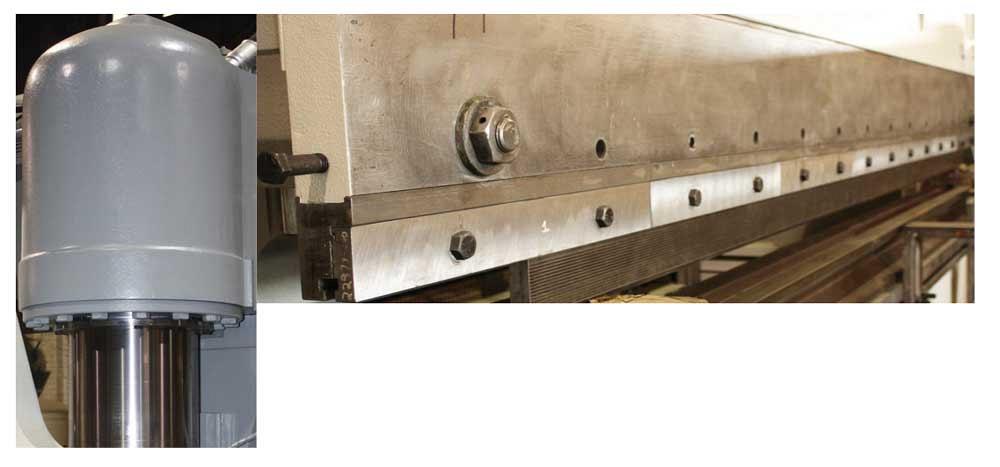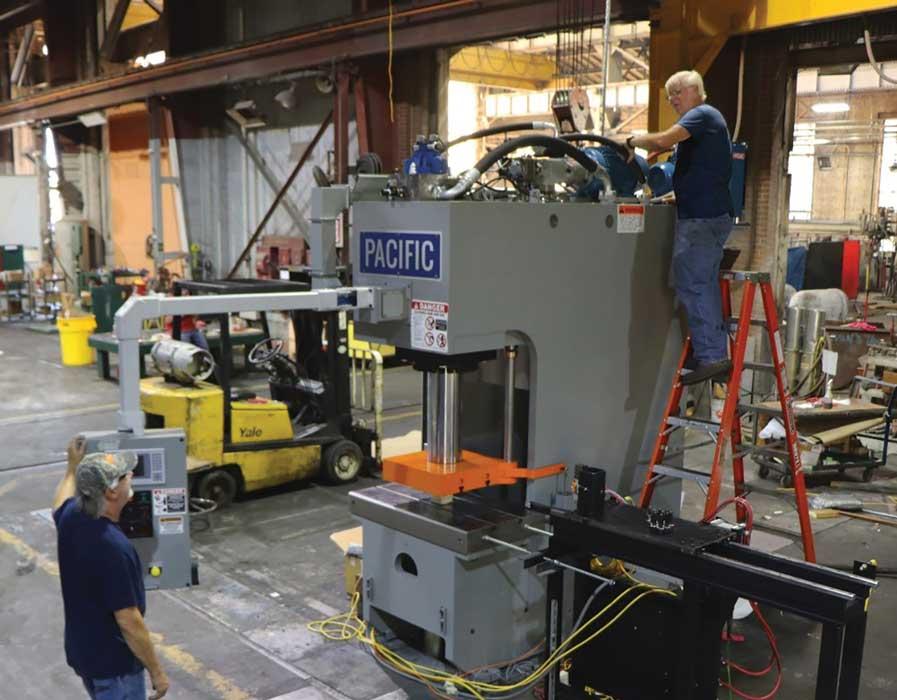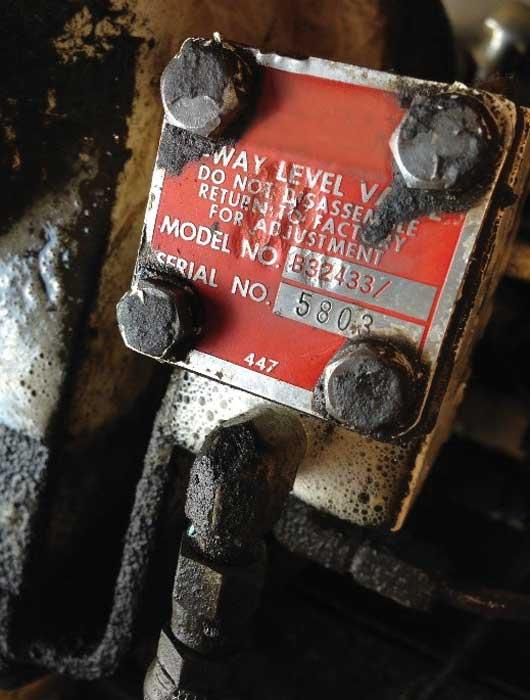Sales Manager
- FMA
- The Fabricator
- FABTECH
- Canadian Metalworking
Categories
- Additive Manufacturing
- Aluminum Welding
- Arc Welding
- Assembly and Joining
- Automation and Robotics
- Bending and Forming
- Consumables
- Cutting and Weld Prep
- Electric Vehicles
- En Español
- Finishing
- Hydroforming
- Laser Cutting
- Laser Welding
- Machining
- Manufacturing Software
- Materials Handling
- Metals/Materials
- Oxyfuel Cutting
- Plasma Cutting
- Power Tools
- Punching and Other Holemaking
- Roll Forming
- Safety
- Sawing
- Shearing
- Shop Management
- Testing and Measuring
- Tube and Pipe Fabrication
- Tube and Pipe Production
- Waterjet Cutting
Industry Directory
Webcasts
Podcasts
FAB 40
Advertise
Subscribe
Account Login
Search
Extend the life of a hydraulic press or replace it?
Do a health checkup before “surgery”
- By Chris Robinson
- November 23, 2017
- Article
- Bending and Forming
You just bought a brand-new hydraulic press in the hope that it will make money for your organization for years to come. The press is working great and stampings are coming off the line at an incredible pace.
Fast-forward 15 years. The press has stopped coming down to a repeatable depth. The electrical system keeps shorting out. So much fluid is leaking from the power unit onto the material that customers are rejecting product.
A decision must be made as to what to do with the press. The machine has been making your company money over the last 15 years, but that is no longer the case. Should you upgrade the existing press or replace it? If you do upgrade it, what items should you focus on updating or replacing?
The following guide can help make that decision easier.
By the Numbers
First, a complete upgrade of a piece of equipment should not cost more than 65 percent of the cost of a new one. Even with a complete hydraulic, electrical, and mechanical upgrade, the frame components are still old. New machines will have a longer life.
The second thing to consider is the depreciation of the asset. New machinery will have a better depreciation schedule than old equipment.
Third, consider the total project cost. When purchasing new hydraulic machinery, you should include auxiliary costs like that of the oil in the machine, foundation work, freight, and rigging. The auxiliary costs of rebuilds and upgrades are only freight and installation.
Mechanical Health
If you’re debating whether to keep and upgrade your press, the first item you should check is the press’s mechanical condition. Does the frame have cracks? How much clearance is in the guiding system, and can it be adjusted? In what condition are the cylinders? Are the bed and slide still in good condition (see Figure 1)?
If the machine frame is in poor condition, it does not make financial sense to upgrade the hydraulic or electrical components. One of the worst decisions a company can make is to put money into a machine that still will not be able to run production even after it has been repaired electrically or hydraulically.
Hydraulic Health
Production problems pertaining to hydraulic systems can range from the slide’s depth repeatability (or lack thereof) to oil leaking on the stampings caused by worn-out cylinder seals. Another problem occurs when debris enters the systems and blocks valves, causing the machine to run out of oil (see Figure 2). In addition, dirty oil causes components to work harder and fail faster. Most problems can be fixed with adjustments and part replacements, but some circumstances warrant a hydraulic system replacement.

Figure 1
Examine your guiding system and cylinders to determine whether they can be retrofitted or replaced.
For example, if the press is not running at the same speeds it once was because the entire system is worn out, or if there are many different problems, it makes sense to evaluate the cost of replacement parts instead of rebuilding an entire system.
There are a couple of considerations related to upgrading the hydraulic system. If your objective is to increase operational speed, you need to check the press’s port sizes to make sure that the system can handle the increased oil flow required to increase speeds (see Figure 3).
Some older presses were designed with hard piping between components. If you want to replace parts, you must carefully evaluate whether the replacement parts will fit within the framework of the piping system or even whether replacement parts even exist. Part designs change over the years; a completely new design may be required if a direct replacement is not available.
Electrical Health
If you were to open an original electrical cabinet on a vintage press, you would see that the layout is very simple. You would see a couple of relays, an incoming power supply, and a couple of fuses.
Since the advent of PLCs and the increase in safety redundancy systems, every new press has been equipped with computers that control the machinery operation and additional backup relays to ensure that the machine will not have unwarranted movement. The relay logic of old has been replaced with programming logic. Components now are updated with better technology at a very fast pace. Subsequently, they become obsolete at a faster rate.
Replacement parts can be difficult to find, or the layout or configuration of the electrical system has been so altered that they no longer work. You should evaluate the electrical system periodically to see how many obsolete components it has. The single most costly and most consistently updated component is the human-machine interface (HMI).
Operational Safety
The press equipment manufacturer has an obligation to construct the machine so that it operates in the safest manner possible. The shop owner is responsible for the operator’s safety. Safety equipment, such as light curtains, area scanners, and physical guarding, can be installed on presses, but many machines are in operation without these features.
Generally, safety devices themselves are not cost-prohibitive, but having the right ones installed by a reputable company and technician adds cost; however, correct installation of safety devices is crucial to the successful and safe operation of the machinery.
Healthy Maintenance
Many old presses still operate with great efficiency. Usually these presses are owned by companies that have taken great measures to preserve their assets. The way they do this is through regularly scheduled maintenance by well-trained maintenance personnel. The maintenance department’s thorough understanding of the system and of which components take priority will allow the maintenance personnel to perform troubleshooting quickly. The following is a good maintenance schedule of tasks:
Daily:
- Listen for unusual noises.
Weekly:
- Inspect terminal blocks.
- Grease guide system.
- Inspect power unit for leaks.
- Check and tighten piston stud nuts.
- Adjust cylinder rod packing.
- Tighten bed bolts.
- Check level valve spring.
- Air blow out channel dies.
Monthly:
- Air blow out heat exchanger.
- Air blow out fan on electrical panel.
- Inspect tooling for damage.
Twice Yearly:
- Take oil sample and send to lab.
Most OEMs offer a maintenance training program for proper functionality of the machinery. The last checkpoint on the health checkup list related to keeping a press operating at peak performance is proper operation. The single worst action that occurs to machinery is overuse and abuse. Time and time again, companies run a press beyond its capacity, which destroys crucial componentry or causes it to develop cracks.
About the Author
Related Companies
subscribe now

The Fabricator is North America's leading magazine for the metal forming and fabricating industry. The magazine delivers the news, technical articles, and case histories that enable fabricators to do their jobs more efficiently. The Fabricator has served the industry since 1970.
start your free subscription- Stay connected from anywhere

Easily access valuable industry resources now with full access to the digital edition of The Fabricator.

Easily access valuable industry resources now with full access to the digital edition of The Welder.

Easily access valuable industry resources now with full access to the digital edition of The Tube and Pipe Journal.
- Podcasting
- Podcast:
- The Fabricator Podcast
- Published:
- 04/16/2024
- Running Time:
- 63:29
In this episode of The Fabricator Podcast, Caleb Chamberlain, co-founder and CEO of OSH Cut, discusses his company’s...
- Industry Events
16th Annual Safety Conference
- April 30 - May 1, 2024
- Elgin,
Pipe and Tube Conference
- May 21 - 22, 2024
- Omaha, NE
World-Class Roll Forming Workshop
- June 5 - 6, 2024
- Louisville, KY
Advanced Laser Application Workshop
- June 25 - 27, 2024
- Novi, MI


































